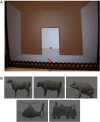Auditory-visual object recognition time suggests specific processing for animal sounds
- PMID: 19384414
- PMCID: PMC2668178
- DOI: 10.1371/journal.pone.0005256
Auditory-visual object recognition time suggests specific processing for animal sounds
Abstract
Background: Recognizing an object requires binding together several cues, which may be distributed across different sensory modalities, and ignoring competing information originating from other objects. In addition, knowledge of the semantic category of an object is fundamental to determine how we should react to it. Here we investigate the role of semantic categories in the processing of auditory-visual objects.
Methodology/findings: We used an auditory-visual object-recognition task (go/no-go paradigm). We compared recognition times for two categories: a biologically relevant one (animals) and a non-biologically relevant one (means of transport). Participants were asked to react as fast as possible to target objects, presented in the visual and/or the auditory modality, and to withhold their response for distractor objects. A first main finding was that, when participants were presented with unimodal or bimodal congruent stimuli (an image and a sound from the same object), similar reaction times were observed for all object categories. Thus, there was no advantage in the speed of recognition for biologically relevant compared to non-biologically relevant objects. A second finding was that, in the presence of a biologically relevant auditory distractor, the processing of a target object was slowed down, whether or not it was itself biologically relevant. It seems impossible to effectively ignore an animal sound, even when it is irrelevant to the task.
Conclusions/significance: These results suggest a specific and mandatory processing of animal sounds, possibly due to phylogenetic memory and consistent with the idea that hearing is particularly efficient as an alerting sense. They also highlight the importance of taking into account the auditory modality when investigating the way object concepts of biologically relevant categories are stored and retrieved.
Conflict of interest statement
Figures



References
-
- Thorpe S, Fize D, Marlot C. Speed of processing in the human visual system. Nature. 1996;381:520–522. - PubMed
-
- Warrington EK, McCarthy R. Category specific access dysphasia. Brain. 1983;106:859–78. - PubMed
-
- Warrington EK, Shallice T. Category specific semantic impairments. Brain. 1984;107:829–54. - PubMed
-
- Humphreys GW, Forde EM. Hierarchies, similarity, and interactivity in object recognition: ‘category-specific’ neuropsychological deficits. Behav Brain Sci. 2001;24:453–476. - PubMed
-
- Caramazza A, Mahon BZ. The organization of conceptual knowledge: the evidence from category-specific semantic deficits. Trends Cogn Sci. 2003;7:354–361. - PubMed
Publication types
MeSH terms
LinkOut - more resources
Full Text Sources

